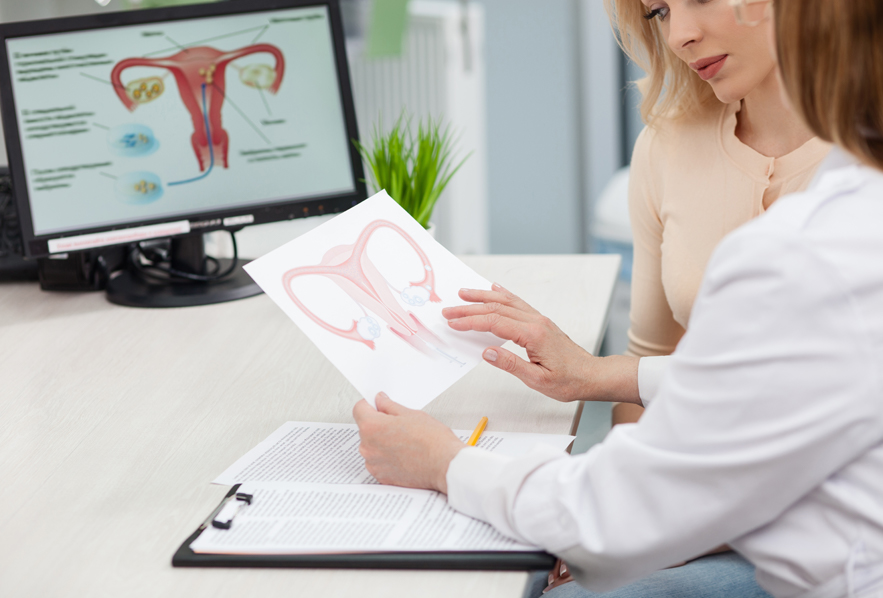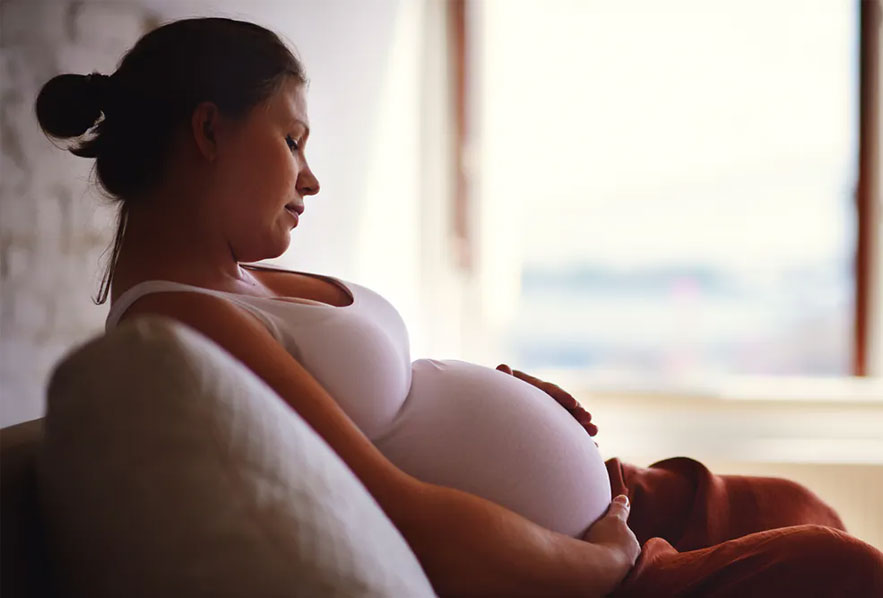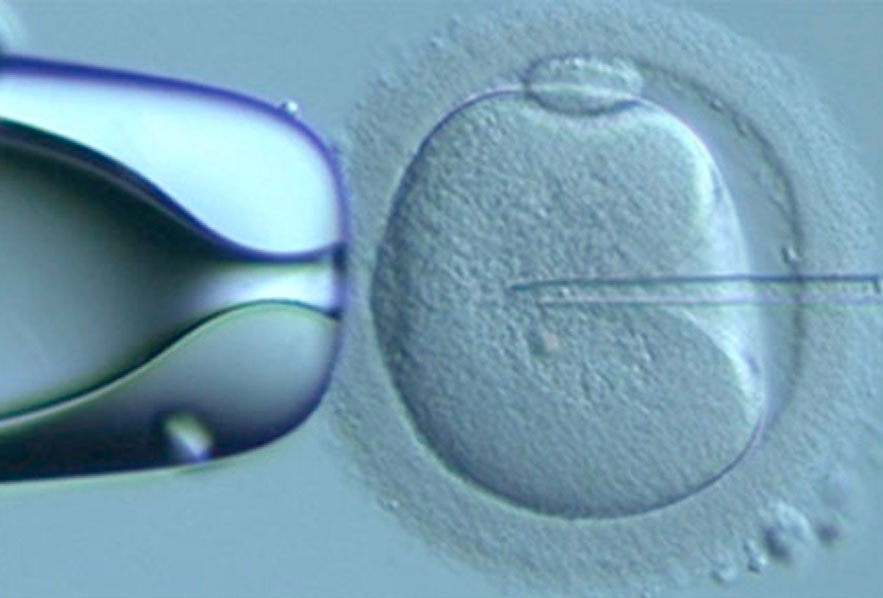One of the steps in assessing a couple’s fertility is checking that the fallopian tubes are working, so the sperm can meet up with the egg and fertilization can occur. Studies have shown that women who have fallopian tube testing have a high conception rate, especially when an oil based fluid called lipiodol is used. We have published studies on lipiodol and are developing guidelines for its safe use. The importance of the fallopian tubes for fertility, the types of tests that can be offered to assess their patency and the pros and cons of using lipiodol will be outlined.
Why the fallopian tube is important.
Fallopian tubes sprout from each side of the uterus and provide a tunnel through which an egg can be transported from the ovary towards the cavity of the womb. Soft finger-like projections at the end of the tube wrap around the ovary during ovulation, channeling the egg into the hollow of the tube. The tube is lined by tiny anemone-like projections that push the egg towards the womb. After intercourse sperm swim to the first part of the fallopian tube where they wait for the egg. The egg releases signals that activate the sperm, which rapidly swim to the egg and surround it. Fertilization occurs in the tube but (unlike the cartoons) about 50,000 sperm collaborate (rather than compete) to fertilize the egg.
This delicate dance between the eggs and sperm that leads to fertilization is critically dependent on the environment in the fallopian tube. Nutrients in the tube nurture the fertilized egg and developing embryo, which eventually moves to the cavity of the womb.
How do we test that the fallopian tubes are working?
There are three ways of testing the fallopian tubes.
- Hysterosalpingogram (HSG): In this procedure a speculum examination is performed and a small tube is placed in the cavity of the womb. A contrast media is injected into the cavity of the womb. An x-ray machine detects this contrast media and can see if it flows through the tubes into the pelvic cavity. The walls of the womb and ovaries can’t be seen but the shape of the womb can be assessed.
- HyCosy: This procedure is similar to an HSG but the contrast media is visualised using ultrasound. This means that the muscle of the womb, the egg numbers in the ovary, the thickness of the lining of the womb and any signs of endometriosis can be assessed.
- Laparoscopy and Dye: Under anaesthetic a small telescope is inserted via the belly button to visualise the pelvic cavity. At the same time blue dye is injected into the cavity of the womb. The surgeon can watch the dye track through the tubes and spill out the end of the tubes. Often the surgeon will look in the womb to check for endometriosis.
The laparoscopy and dye takes place while you are asleep. You are awake for the HSG and HyCosy. Most people take non-steroidal anti-inflammatories like ibuprofen 1-2 hours before these two procedures.
How do the fallopian tubes become blocked?
Infection is the main reason that fallopian tubes become blocked. Sometimes this is due to sexually transmitted diseases like Chlamydia or Gonorrhoea. Another cause is after a gynaecological operation like a D&C (dilation and curettage). Some women retain a small piece of placenta after a term delivery, premature birth or miscarriage and this can act as a focus for infection. Finally infection from a ruptured appendix can also affect the fallopian tubes. When any of these pelvic infections occur, the inflammatory reaction in the pelvic cavity and inside the tubes causes scar tissue (adhesions) which can block the tubes and make it impossible for the sperm to meet the eggs.
Can having a tubal test improve my fertility?
A large trial which was conducted in the Netherlands showing a higher rate of pregnancy after a HSG for couples who had unexplained fertility. Fertility rates were even higher when the contrast media that was used was oil based (lipiodol).
Lipiodol is registered for use during an HSG but there is less data about its use during a HyCosy. Some surgeons have also used it during a laparoscopy and dye but we know even less about the risks and benefits of this.
Australia has been one of the first countries to rapidly adopt oil contrast media as a fertility treatment for couples with unexplained fertility. There is also some evidence that it particularly helps endometriosis-associated fertility problems.
Couples who conceive after lipiodol use then don’t have to have IVF and more expensive treatments.
What are the down sides of oil contrast media?
The main issue with using lipiodol is its cost of about $500 Australian dollars on top of the costs of the procedure.
Lots of work has been done on the safety of lipiodol and complications are very rare.
One rare risk is that the oil contrast media will go into the blood stream (intravasation) and travel to another organ like the lungs. To minimise the chance of this the person undertaking the HSG or HyCosy will flush the tubes first to check they are not blocked, and will check that there is no leakage of lipiodol into the blood vessels. The procedure will be stopped if either there is any risk of intravasation.Other very rare risks include lipiodol being retained in the pelvis (granuloma) or ongoing pain. If you are allergic to poppy seed oil or iodine, lipiodol can’t be used.
Lipiodol contains high levels of iodine which can mildly suppress the production of thyroid hormone in the short term. Thyroid hormone levels should be monitored after the procedure. This is particularly important if you have a positive pregnancy test as babies need good levels of thyroid hormone to develop and you may need to take thyroid supplements.
What if my tubes are blocked?
If the fallopian tubes are blocked then the egg and sperm can’t meet. The best treatment is IVF as we bypass the fallopian tubes by taking the eggs out of the ovary, fertilizing them with sperm in the lab and placing the embryo in the womb.
If the tubes have been damaged but not completely blocked, embryos can get caught up in scar tissue and implant in the wall of the fallopian tube. This creates an ectopic pregnancy and carries the risk of rupturing the tube and causing internal bleeding. If you have had a pelvic infection or previous tubal damage, we monitor early pregnancy very closely and do an early scan to ensure the pregnancy is in the body of the womb.
What if tubal blockage is due to a tubal ligation?
It is possible to perform surgery to join up a fallopian tube in a procedure called reversal of tubal ligation. This gives couples a chance of conception each month (one egg chance) rather than only in the month when they do an IVF cycle (but many egg chances in that month). The reason that a reversal is possible after a tubal ligation is that the blockage only affects one part of an otherwise healthy tube. When infection has damaged the tube, adhesions and scar tissue tend to be seen the whole way along.
What if my tubes are blocked at the distal end near the ovary?
If the tube is blocked at the distal end, fluid from the tube is prevented from flowing into the pelvic cavity. This fluid collects in the tube and makes it swell up (this is called hydrosalpinx). The sperm and eggs can’t meet to fertilize in this tube but even worse the fluid in the tube becomes stale and a bit toxic to eggs, sperm and embryos. It can trickle back into the uterus and make it difficult for embryos, that were created in the other (hopefully) healthy tube or in the IVF lab, to implant as the uterine environment is inflammatory. Women with hydrosalpinx often notice a watery, dark brackish discharge in the middle of the cycle around ovulation.
Although it is possible to open up the distal end of the tube surgically, it can close over again. If couples are using IVF most clinicians would recommend removing the fluid filled fallopian tube (hydrosalpinx) as it improves IVF pregnancy rates.
If it is too technically difficult to remove the tube we sometime put a clip on the early part of the tube to prevent the fluid trickling back into the uterus.
Summary
The tests of tubal patency can reveal why couples are having fertility problems. They often lead us to the best treatment for a particular couple and reduce the time to a healthy pregnancy.
Natural fertility can be improved by a new oil based contrast media and may help a couple avoid IVF and other expensive techniques. If tubal damage is significant, IVF may be the best option and waiting for natural conception may just delay conception.
Tubal tests can also help us manage the risk of ectopic pregnancy, necessitating close monitoring and early pregnancy scanning if they reveal signs of tubal damage. Fallopian tube tests are essential tools for fertility specialists and help us provide the best care for our patients.




